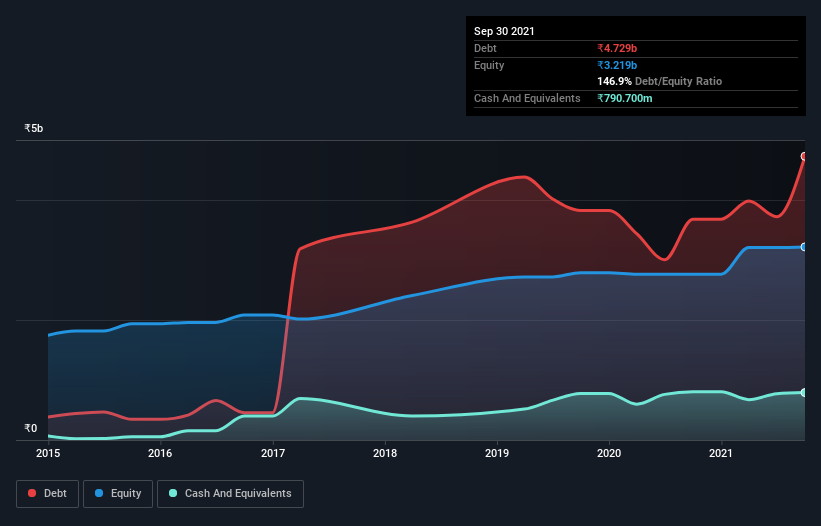- India
- /
- Auto Components
- /
- NSEI:HITECHGEAR
Does Hi-Tech Gears (NSE:HITECHGEAR) Have A Healthy Balance Sheet?
David Iben put it well when he said, 'Volatility is not a risk we care about. What we care about is avoiding the permanent loss of capital.' So it might be obvious that you need to consider debt, when you think about how risky any given stock is, because too much debt can sink a company. We can see that The Hi-Tech Gears Limited (NSE:HITECHGEAR) does use debt in its business. But the real question is whether this debt is making the company risky.
When Is Debt Dangerous?
Generally speaking, debt only becomes a real problem when a company can't easily pay it off, either by raising capital or with its own cash flow. Part and parcel of capitalism is the process of 'creative destruction' where failed businesses are mercilessly liquidated by their bankers. While that is not too common, we often do see indebted companies permanently diluting shareholders because lenders force them to raise capital at a distressed price. By replacing dilution, though, debt can be an extremely good tool for businesses that need capital to invest in growth at high rates of return. The first step when considering a company's debt levels is to consider its cash and debt together.
View our latest analysis for Hi-Tech Gears
What Is Hi-Tech Gears's Debt?
As you can see below, at the end of September 2021, Hi-Tech Gears had ₹4.73b of debt, up from ₹3.68b a year ago. Click the image for more detail. However, it also had ₹790.7m in cash, and so its net debt is ₹3.94b.

How Healthy Is Hi-Tech Gears' Balance Sheet?
The latest balance sheet data shows that Hi-Tech Gears had liabilities of ₹3.68b due within a year, and liabilities of ₹3.26b falling due after that. Offsetting these obligations, it had cash of ₹790.7m as well as receivables valued at ₹2.00b due within 12 months. So its liabilities outweigh the sum of its cash and (near-term) receivables by ₹4.15b.
This deficit is considerable relative to its market capitalization of ₹4.41b, so it does suggest shareholders should keep an eye on Hi-Tech Gears' use of debt. This suggests shareholders would be heavily diluted if the company needed to shore up its balance sheet in a hurry.
In order to size up a company's debt relative to its earnings, we calculate its net debt divided by its earnings before interest, tax, depreciation, and amortization (EBITDA) and its earnings before interest and tax (EBIT) divided by its interest expense (its interest cover). Thus we consider debt relative to earnings both with and without depreciation and amortization expenses.
Hi-Tech Gears has a debt to EBITDA ratio of 3.8 and its EBIT covered its interest expense 4.6 times. This suggests that while the debt levels are significant, we'd stop short of calling them problematic. Notably, Hi-Tech Gears's EBIT launched higher than Elon Musk, gaining a whopping 172% on last year. When analysing debt levels, the balance sheet is the obvious place to start. But it is Hi-Tech Gears's earnings that will influence how the balance sheet holds up in the future. So if you're keen to discover more about its earnings, it might be worth checking out this graph of its long term earnings trend.
Finally, while the tax-man may adore accounting profits, lenders only accept cold hard cash. So we always check how much of that EBIT is translated into free cash flow. In the last three years, Hi-Tech Gears's free cash flow amounted to 23% of its EBIT, less than we'd expect. That's not great, when it comes to paying down debt.
Our View
Neither Hi-Tech Gears's ability to handle its total liabilities nor its net debt to EBITDA gave us confidence in its ability to take on more debt. But the good news is it seems to be able to grow its EBIT with ease. When we consider all the factors discussed, it seems to us that Hi-Tech Gears is taking some risks with its use of debt. So while that leverage does boost returns on equity, we wouldn't really want to see it increase from here. There's no doubt that we learn most about debt from the balance sheet. However, not all investment risk resides within the balance sheet - far from it. These risks can be hard to spot. Every company has them, and we've spotted 4 warning signs for Hi-Tech Gears (of which 2 are a bit unpleasant!) you should know about.
When all is said and done, sometimes its easier to focus on companies that don't even need debt. Readers can access a list of growth stocks with zero net debt 100% free, right now.
Valuation is complex, but we're here to simplify it.
Discover if Hi-Tech Gears might be undervalued or overvalued with our detailed analysis, featuring fair value estimates, potential risks, dividends, insider trades, and its financial condition.
Access Free AnalysisHave feedback on this article? Concerned about the content? Get in touch with us directly. Alternatively, email editorial-team (at) simplywallst.com.
This article by Simply Wall St is general in nature. We provide commentary based on historical data and analyst forecasts only using an unbiased methodology and our articles are not intended to be financial advice. It does not constitute a recommendation to buy or sell any stock, and does not take account of your objectives, or your financial situation. We aim to bring you long-term focused analysis driven by fundamental data. Note that our analysis may not factor in the latest price-sensitive company announcements or qualitative material. Simply Wall St has no position in any stocks mentioned.
About NSEI:HITECHGEAR
Hi-Tech Gears
Manufactures and sells auto components for automobile manufacturers in India, the United States, and internationally.
Flawless balance sheet average dividend payer.
Market Insights
Community Narratives




